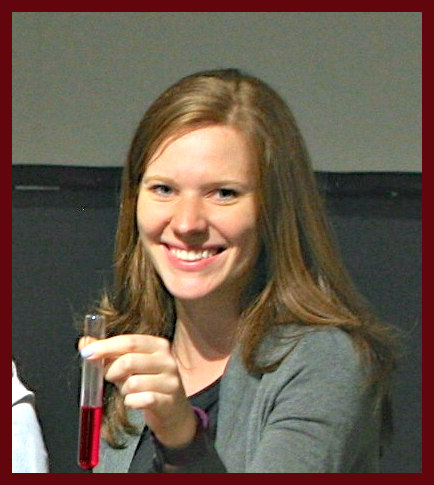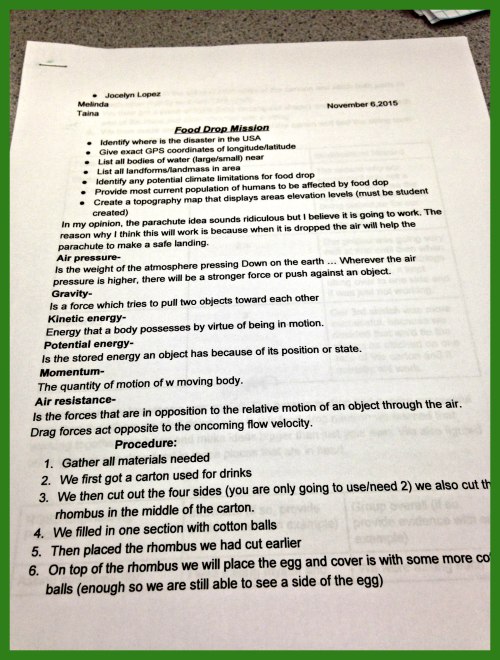Earlier in the month I emailed some of the great teacher participants in the Golden Apple STEM Institute partnership schools, asking them to reflect on 2016 and share one New Year’s Resolution they have for STEM in 2017. What follows are a selection of those resolutions. Maybe they will spark some ideas about what you might want to do in your own STEM classroom in 2017.
Several teachers responded with very specific goals, often focusing on particular content areas they want to work on or, given that NGSS is still relatively new, on NGSS implementation itself.
“My new year’s resolution is that I want to continue to create new science units that align with the NGSS standards.” Keniesha Charleston, 2nd grade, Murray Elementary
“I would like to do at least one Science and Math integrated lesson with my teaching partner a quarter that combines the skills we are teaching in Math and Science.“ Jill Ryan, 6th grade, Durkin Park Elementary
“One of my aspirations this year is to collaborate with the kindergarten teachers to enhance their unit on the study of butterflies. We will develop a unit where students will research the life cycle of a butterfly and apply that new knowledge to create a habitat that would best sustain the life of the butterfly through each stage of its life cycle.” Amanda Conway, STEM Coordinator, Pershing Elementary
“My resolution for next year is to try to come up with at least one new activity or performance assessment that will incorporate NGSS and STEM in my classroom and to keep the students engaged with inquiry and problem solving.” Mike Albro, 7th – 8th Science, Byrne Elementary
For some teachers, 2017 will offer opportunities for integrating the STEM subjects with the arts, thereby moving toward STEAM-based experiences for their students.
” For my New Year resolution, I would like to include more art projects into my curriculum, turning my STEM classroom into a STEAM classroom. As Einstein said, ’Imagination is more important than knowledge.’ I believe I can develop my students’ imaginations in a greater and more deliberate way by adding art to the projects they do in my class.” Joe Estela, Upper Grades Science, Nightingale Elementary
“My resolution for 2017 is all about my dream for an event/unit with my middle school students in February. It is called STEAMPunk (Science, Theatre, Entertainment, Arts, Music, Powerful, United, Next Generation, Kids). I developed a unit that will connect an experiment design project with a music, visual arts, or theatre piece that is created by the student to show off the new knowledge learned from the science experiment as well as new knowledge about that discipline of art. Please come if you are available on February 1, 2017, during the day of course. I am inviting everyone out to listen, watch, learn and enjoy art our middle schoolers create. This is an overwhelming feat that has taken collaboration and patience between students, art teachers, and myself. Give everything you can to a dream. Communicate it, plan it, reflect on it, and do the work in order to make sure it comes true.” Kelly Harris Preston, 8th grade Science, Brentano Elementary
Since the advent of the Next Generation Science Standards, Engineering is a new element in the science classroom, so it’s not surprising that a number of these great teachers will be focusing on incorporating more engineering activities into their instructional plans.
“For the New Year, I will focus more on engaging my students in the Engineering Design component of NGSS.” Anh Hoang, 2nd grade, Murray Language Academy
“My STEM Resolution for 2017 is to align an engaging engineering lab for each of the Holidays that occur during the school calendar year. Combining festive themes with critical problem solving skills is a WIN-WIN! My classroom engineers ‘win’ because they think they are ‘getting out of class’ with our holiday themed project/activity. And I WIN, because I know they are being exposed to multiple engineering practices. Cara West, 6th grade, Durkin Park Elementary
Several teachers couldn’t limit themselves to just one STEM Resolution. In their lists, they reveal thoughtful, concrete plans, a blueprint for transforming their STEM classrooms in the coming year.
“I want to
• Continue to convince students they can be good in science and math by implementing interesting, rigorous, hands on STEM activities. (STEMscopes is aligned with NGSS).
• Take students to more real world workplaces to experience how STEM is integrated.
• Have students sign up for this weekly newsletter I just found called STEM Jobs.” (VERY COOL, BTW!)
Ain Muhammad, STEM Coordinator, Wentworth STEM Academy
“My New Year’s Resolutions are to
• Contact all Chicago Museums and have them support me as I create Inquiry-Based projects in my classrooms. (I did have a difficult time thinking about an inquiry-based project as I worked on the Food Chain and Food Webs. Having the support of the Museum of Science and Industry, Lincoln Park Zoo, and Peggy Notebaert Nature Museum will help me create an exciting curriculum for my students.)
• Increase parental involvement in and outside the classroom to promote the STEM curriculum. (I need parents to come into the classroom to provide adult supervision as students are actively engaged in their investigations. I also need them to continue fostering the children’s natural curiosity at home in the field of science and technology.)
• Start collecting my science materials for my future projects.
• Make ALL my students enjoy SCIENCE through the use of inquiry-based lessons. (I wish I had been taught Science using STEM and inquiry. It would have made a WORLD OF DIFFERENCE!!!!)” Maria Soto, 2nd grade, Washington Elementary
Teaching STEM is not always the easiest job in the world, particularly given the neglect of science education over the past decades and the compartmentalization of subjects begging to be integrated. But some teachers say with absolute determination, “Bring it on!”
“I will dedicate this new year to finding exciting and relevant ways to teach and engage my students, while always keeping an open mind to refining or restructuring what has already been taught.” Jake Pagan, 6th grade, Morrill Elementary
“For the new year, I would like to try to get my grade level team more excited about science by planning hands-on team assignments — maybe, even a grade level competition.” Stacy Gibson, 1st grade, Tonti Elementary
“This New Year I want to embrace the fact that students want to learn about things I am not supposed to teach in 3rd grade. As we immerse students into inquiry, some questions veer from my original objectives but are such high quality questions I want to find ways to support their investigations that may be ‘off topic.’ I know this requires increased flexibility but starting in January, I am up for the challenge!” Brittany Williams, 3rd grade, Brentano
In other words,
“Think STEM and Persevere!” Chanel Simpson, Drake Elementary
The final four resolutions are more global and reflect the powerful human connection between our lives and our teaching and the grit and optimism that it takes to thrive in today’s classrooms. They move outside an individual classroom, pointing to the wider world beyond and to the future.
“My STEM resolution for 2017 is to have it be the vehicle to make more students believe and know they can change the world with just their mind.” Letitia Dennis, 8th grade, Gillespie Technology Magnet School
“As I reflect on this year, I think I look forward to the growth in rich, engaging, and deep discussions my students will have in connection to STEM. I hope in this school year and in the years to come, I will be able to support and inspire my students to think, question, wonder, and hold meaningful discussions about science in ways that others may not have thought before.” Winnie Ho, STEM Coordinator, Everett Elementary
“My resolution is to emphasize how important it is to teach with a STEM focus. It not only serves as a means for approaching math and science content, but also presents the opportunity to introduce critical global challenges into the consciousness of future generations that will feel the impact at a much greater level than we do.” William Campillo, STEM Coordinator, Hernandez Math and Science Academy
“My New Year’s resolution for 2017 is to focus on what I love most, myself, my family, my friends, and of course, science! As an administrator, I am going to go back to my roots as a science teacher, coach, and coordinator to make an impact in our school. 2017 will be a GREAT YEAR!!!” Michelle Smith, Assistant Principal, Clissold Elementary
With all of this intelligence, creativity, and energy directed at improving STEM instruction just in this small sampling of classrooms, 2017 will indeed be a GREAT YEAR!!! … most especially for the students of these awesome teachers. I want to thank each of them for sharing their STEM resolutions.
And if you happen to be based in a Chicago Metro area school, why not consider exploring a partnership with Golden Apple STEM Institute as one of your resolutions for 2017?
Happy New Year!!
~ Penny
You can learn more about Golden Apple STEM Institute here.






















